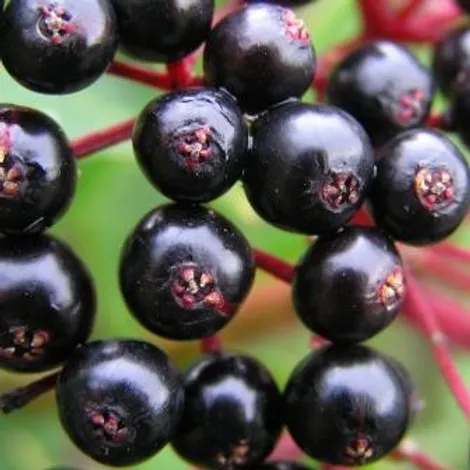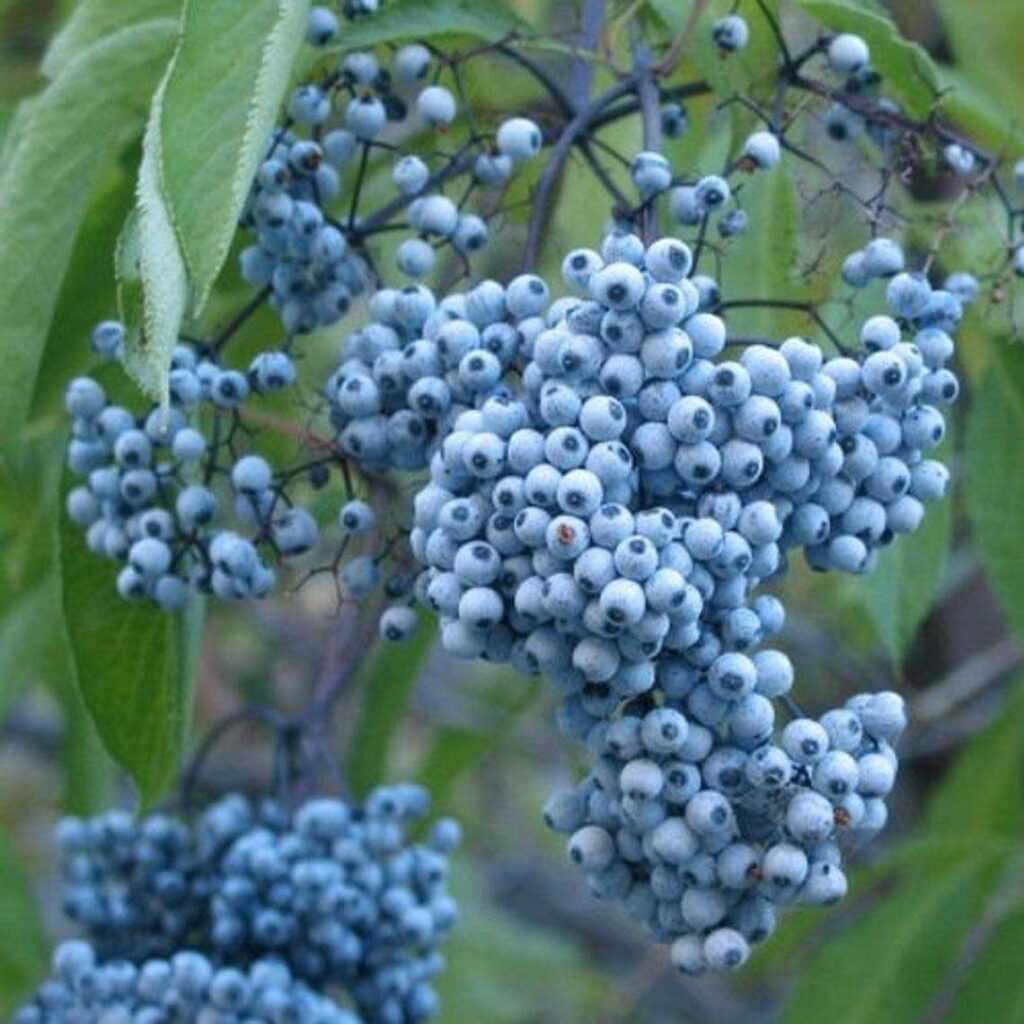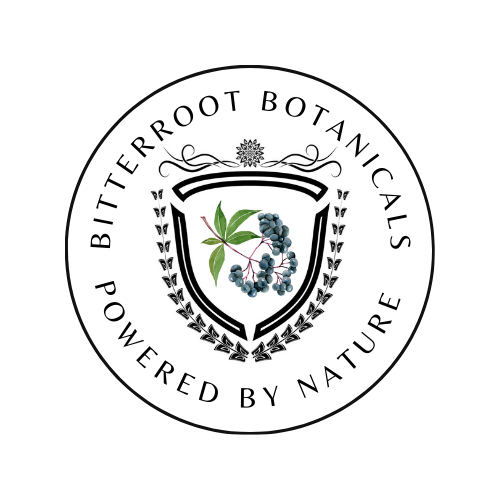WHAT ABOUT THOSE ELDERBERRIES???
ABOUT THE BERRIES
There are many varieties of elderberries. Since our Wild Harvest and products consist of Sambucus Nigra L or European Elderberry and Sambucus Canadensis or American Elderberry these will be the focus of this writing. We commonly refer to them as “Black Elderberries” and “Blue Elderberries” respectively.


Both of these are considered edible WHEN COOKED, but the leaves, bark and other parts of the bushes are toxic. I encourage you, as always, to know what you are eating. Here’s a link to help you identify elderberries; https://www.ediblewildfood.com/elderberry.aspx. Please, and I can’t emphasize this enough, be careful when wild foraging for food. Know what you are looking for, and do your research first. When in doubt, check it out. There are also several apps available for plant identification. Simply snap a photo with your smart phone, and look at the results. Even after using one of these apps, investigate further before you eat anything you harvest!!! Both black and blue elderberries grow wild in our area. The blue ones are more common, typically harvested in September and October when they have the light blue “dusty” appearance. The black variety is for whatever reason found at much higher elevations, around 5000′, and ripens earlier, usually in late August and early September. Elderberries are a common source of food for wildlife, and we frequently spot a nice bush that isn’t quite ripe, only to return a week later and find it stripped by birds, or completely mangled by elk, bears, and other critters. This is all part of the Wild Craft experience and I actually enjoy looking around to see who stole my berries!! Remember, this is more about the experience of being in nature, learning, and less about what you actually come home with. Of course alternatively you could go out for a nice walk in nature, come home and order your elderberry syrup from us.
USES FOR ELDERBERRIES
Once again, I will caution you not to consume raw elderberries. On the first elderberry picking adventure I took my son on, he was around eight years old, he ate a small handful of raw berries. We had spent much of the Summer picking Blackberries and Wild Raspberries with us, and was used to eating as many as he could. I have no idea what possessed him to eat Elderberries ‘cuz they’re really not tasty. I took it in stride, returned home, told his Mom, and we waited and watched. Over the next few hours, he started to get a stomach ache, then moderate diarrhea, at which point, we as good parents (although truly good parents wouldn’t have allowed him to eat raw elderberries) called the poison control center. After answering their questions as best we could (how many grams did he eat? lol), they told us to monitor him and if conditions worsened, take him to the emergency room. He was fine the next day. Still, be careful out there.
Elderberries are commonly cooked down or steam juiced and the liquid is then used for syrup or jelly. They are frequently combined with other fruits like apples, peaches, apricots, blackberries to sweeten and improve their flavor. Elderberries by themselves are not really yummy like other wild berries. They can also be added to pies, cobblers, cakes and tarts for added color and a “tart or bitter” flavor if desired. We use the syrup we produce as a flavoring for beverages. I personally really like a glass of half sparkling water (from our sodastream), half home brewed kombucha (more about kombucha in a post later), and a tablespoon of Bitterroot Botanicals of Idaho Elderberry syrup. I personally don’t drink alcohol, but I’ve been told that a tablespoon in your favorite vodka or bourbon is delicious. I’ve also heard that Elderberry Syrup martinis are popular. It also makes a nice glaze for wild game or steelhead and salmon. Since Elderberry is a close cousin of the grape, one of the most common uses is homemade Elderberry wine. Again, I’m not a drinker, but I’ve always wanted to try my hand at this, and will write about the experience and outcome in a later post.
I’m going to exercise an abundance of caution here because it’s a very touchy subject and I don’t want any warning letters from the FDA, but Elderberry products have seen a huge increase in popularity lately as a supplement. Bitterroot Botanicals Wild Crafted Elderberry Syrup is manufactured, packaged, labeled and sold as a food product. We make no claims about health benefits and in fact, I will be scouring our website to be certain that we don’t. The reason you purchase and how you choose to use our product is up to you. But…. the fact remains, many suppliers, both large and small, make claims about their products. Big producers have flooded the market with products. Local folks are merrily picking berries and concocting their own syrups, tinctures, extracts and tonics through a variety of techniques and using untold numbers of additional ingredients. I think it’s sufficient to say there’s a lot of options out there. Of course, ours is better, and I’ll explain why in the future.
THE FDA AND ELDERBERRIES IN AN IMPOSSIBLE SITUATION
The Food and Drug Administration (FDA) , an agency within the the US Department of Health and Human Services, protects the public health by
assuring the safety, effectiveness, and security of human and veterinary drugs, vaccines, and other biological products for human use and medical devices. The agency also is responsible for the security and security of our nations food supply , cosmetics, dietary supplements and products that give off electronic radiation, and for regulating tobacco products (taken from the FDA website) WOW!!! That’s a pretty tall order. Being responsible for approval of food and drug products means that they have control of around 25% (from a quick google search) of the annual dollars spent in the US.
Another quick Google search yielded (as usual) several differing bits of information regarding FDA funding. One source indicated that the annual budget of $6 billion dollars is 55% paid by the federal government and 45% by industry user fees. Another source stated that industry user fees were over $9 billion in 2019. Either way, the industry user fees put “the fox in charge of the hen house”. These are all numbers that are in a constant state of change (likely increased) during the current COVID19 crisis. The FDA, much like a private business, is largely supported by it’s “customers”, and simply can’t afford to piss them off. The FDA “customer” or user list reads like a veritable who’s who of Big Pharma and Big Ag and includes names like Pfizer, Roche, Novartis, Merck, GlaxoSmithKline on the pharmaceutical side, and Nestle, Pepsico, JBS, and Tyson on the food side. The fox in charge of the hen house?
Lets assume for the moment that on the food side, elderberries are considered safe for consumption by the FDA and look at the potential health benefits. If a company like Pfizer, or Merck, believed that there was some potential benefits to elderberry or derivatives from elderberries they would need to get FDA approval. This would involve a lengthy and costly process including discovery/concept phase, preclinical research phase, clinical research phase, FDA review, and FDA post-market safety monitoring. This process can take up to to ten years and cost potentially billions of dollars. Ultimately, the pharmaceutical company would end up needing to create synthetic elderberries or derivatives in order to patent their “discovery”. a year later people, including their shareholders lol, would flock to the mountains and pick elderberries. The net result would be a huge capital loss. Their shareholders, in spite of their recent Wild Crafting adventures picking elderberries would say “No Bueno”, we need profits. So, lets face it, it ain’t gonna happen Cap’n.
I think it’s important to not that many pharmaceuticals and common over the counter drugs began as naturally occurring compounds ie; aspirin, interferon, morphine, penicillin and others. Conversely, I could compile a vast list of plants, fungi, and other natural items with potential medical benefits that most likely will NEVER BE APPROVED FOR MEDICINAL USE IN THE US, simply because there would be no potential for financial gain. No profits, no research, no research no review, no review, no possible benefits, no possible benefits no drug. Elderberries, certain mushrooms and other fungi, various mosses, juniper berries, spices, mullein, common cattails, calendula (marigold), mint, I could go on forever. The point here is, with some research and knowledge, some belief in nature providing us with valuable resources, some hard work, and a spirit of adventure, we can all benefit from Wild Harvesting and Wild Crafting. The benefits go beyond nutrition and health for our bodies to mental and spiritual health which can certainly be found by spending time outdoors. Plus, it’s a great opportunity to take that mask off and get social with the birds, bees, and whatever else you might find out there.
Bitterroot Botanicals of Idaho has gone through the costly, time consuming, and frustrating process of having FDA nutritional content labeling created and approved for our Wild Crafted Elderberry Syrup, but that’s where it will end. There will be no discovery/concept phase, no clinical research, no FDA review. We will continue to produce our food product in our cozy commercial kitchen, and distribute it to people who appreciate it for what it is and how it is produced. We will do this with hard work, gratitude, and a continued and growing focus on the natural world we live in.

